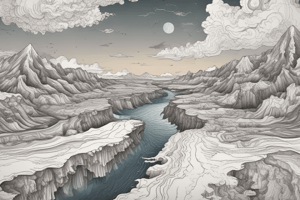Podcast
Questions and Answers
What is the main difference between a hypothesis and a theory?
What is the main difference between a hypothesis and a theory?
- A hypothesis is confirmed through further investigation, while a theory is validated through observation only.
- A hypothesis explains a natural phenomenon, while a theory acts as the foundation for further investigation.
- A hypothesis is an educated guess based on data, while a theory explains a natural phenomenon. (correct)
- A hypothesis is validated through observation and experimentation, while a theory is an educated guess based on data.
What did Alfred Wegener hypothesize about the continents?
What did Alfred Wegener hypothesize about the continents?
- They drifted in the oceans independently.
- They were static and never moved.
- They were once connected in a supercontinent called Pangaea. (correct)
- They were created through volcanic eruptions.
What does the term 'PANGAEA' mean in Greek?
What does the term 'PANGAEA' mean in Greek?
- 'All fire'
- 'All water'
- 'All land' (correct)
- 'All air'
Which observation supported the Continental Drift Hypothesis proposed by Alfred Wegener?
Which observation supported the Continental Drift Hypothesis proposed by Alfred Wegener?
What does the Sea Floor Spreading Hypothesis explain?
What does the Sea Floor Spreading Hypothesis explain?
Why was Wegener's idea of Continental Drift initially met with skepticism?
Why was Wegener's idea of Continental Drift initially met with skepticism?
What hypothesis was based on observations but rejected by other scientists due to the inability to identify the source of the force needed for continents to move?
What hypothesis was based on observations but rejected by other scientists due to the inability to identify the source of the force needed for continents to move?
Who was the American geophysicist and Naval officer credited with observing a continuous chain of huge mountain ranges or mid-ocean ridges, leading to the Sea-Floor Spreading Hypothesis?
Who was the American geophysicist and Naval officer credited with observing a continuous chain of huge mountain ranges or mid-ocean ridges, leading to the Sea-Floor Spreading Hypothesis?
What theory explains the formation of new oceanic crust that leads to the movement of plates?
What theory explains the formation of new oceanic crust that leads to the movement of plates?
Which fact about the rocks on either side of a mid-ocean ridge supported the Seafloor Spreading hypothesis?
Which fact about the rocks on either side of a mid-ocean ridge supported the Seafloor Spreading hypothesis?
Who conducted the mapping of large areas of the oceans for the first time during World War II to locate enemy submarines?
Who conducted the mapping of large areas of the oceans for the first time during World War II to locate enemy submarines?
Which event led to the acceptance of the Seafloor Spreading hypothesis as valid after its discovery?
Which event led to the acceptance of the Seafloor Spreading hypothesis as valid after its discovery?
What geological evidence supports the theory of Continental Drift?
What geological evidence supports the theory of Continental Drift?
How does the geological fit between eastern South America and West Africa provide evidence for plate tectonics?
How does the geological fit between eastern South America and West Africa provide evidence for plate tectonics?
Why is the presence of glacial deposits during the Permo-Carboniferous glaciation in Antarctica, Africa, South America, India, and Australia significant in understanding Earth's history?
Why is the presence of glacial deposits during the Permo-Carboniferous glaciation in Antarctica, Africa, South America, India, and Australia significant in understanding Earth's history?
What phenomenon is responsible for the formation of isolated fossils found on separate continents and nowhere else?
What phenomenon is responsible for the formation of isolated fossils found on separate continents and nowhere else?
How does the distribution of fossil evidence across continents support the theory of PANGAEA?
How does the distribution of fossil evidence across continents support the theory of PANGAEA?
How does the finding of ancient rock outcrops over 2,000 million years old continuous from one continent to another contribute to our understanding of Earth's history?
How does the finding of ancient rock outcrops over 2,000 million years old continuous from one continent to another contribute to our understanding of Earth's history?
Flashcards are hidden until you start studying




